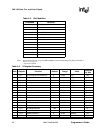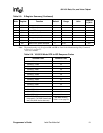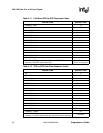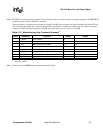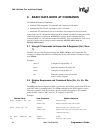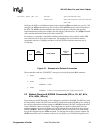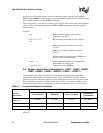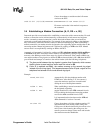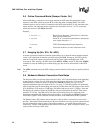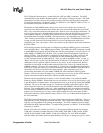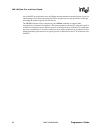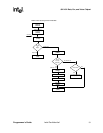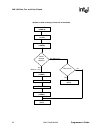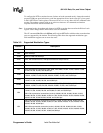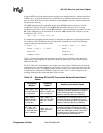
56K V.92 Data, Fax, and Voice Chipset
28 Intel Confidential Programmer’s Guide
3.6 Online Command Mode [Escape Codes, On]
After establishing a connection with a remote modem, the DTE sends the appropriate escape
sequence to the DCE, which causes the DCE to enter the online command mode. The online
command mode is used to send AT commands to the DCE while the DCE is still connected to the
remote modem. The supported escape sequences are described in Section 3.10. To re-enter the
online data mode, use the ATOn command.
Example:
1 second +++ Hayes Escape Sequence. Guard times (in which the
DTE does not send data to
1 second the DCE) of 1 second are needed before and after the
three escape characters “+”.
+++AT<CR> TIES (Time Independent Escape Sequence).
ATO Causes the modem to re-enter online data mode.
3.7 Hanging Up [Hn, S10, Zn, &D2]
A modem connection terminates when the modem hangs up or when the remote modem transmit
carrier is off longer than the duration specified in S-register S10. To hang up, the DTE typically
sends an escape code sequence that causes the DCE to enter online command mode. Upon
receiving an “OK” message, the DTE sends either ATH or ATZn to the DCE. When the AT&D2
command is used, the modem goes on-hook (hangs up) after an on-to-off transition of the DTR
occurs.
Note: The ATZn command causes the DCE to hang up and re-initialize itself to the user profile specified
by ‘n’.
3.8 Modem-to-Modem Connection Data Rates
The data rates differ for each data mode selected. V.90 or V.92 is the default data mode depending
on the firmware version. For non-V.90 connections the chipsets fall back to V.34 mode. The
modem defaults to whatever mode is issued by the +MS=m command (see page 56). The
supported modulation types are listed in Table 3-2 on page 33. This table includes all modulation
types and the data rates for transmitting and receiving. In Data mode, the 56K chipsets can transmit
up to 48,000 bps (V.92 mode) or 33,600 bps (V.90 mode) and receive up to 53,333bps. Note that
the chipsets are capable of achieving 56,000 bps, but power limitations by the FCC limit actual
speeds to 53,333 bps. The 56K receive data rates can be achieved only in connections with
equipment-compatible ISPs (Internet Service Providers). In V.92 mode, the MD566X supports 3
new features: Quick Connect, Modem-on-Hold and Pulse Code Modulation (PCM) Upstream.
The Quick Connect (QC) feature reduces the time it takes to make a connection to your service
provider. The modem retains information of the line conditions from your previous connection and
uses this information to bypass parts of the training sequence. As a result, this provides faster
connections. Normal V.90 connections take about 25-30 seconds. With V.92 Quick Connect, your
connect times can be up to 50% faster.



